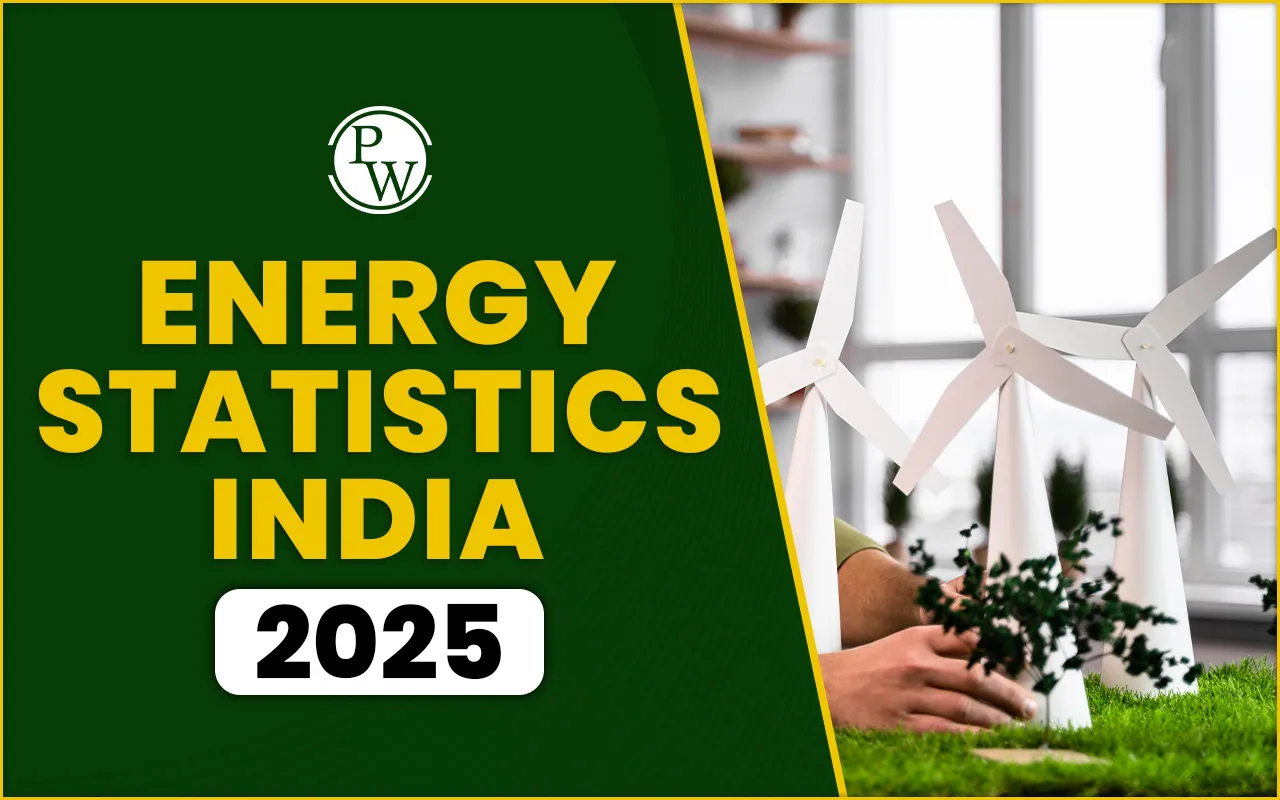
The Energy Statistics India 2025 report, released by the National Statistics Office (NSO), highlights India's steady growth in energy supply and consumption during the Financial Year 2023-24. The report provides valuable insights into the country's energy reserves, production, import-export trends, and sustainable energy indicators. Read on to learn more about Energy Statistics India 2025.
NSO’s Energy Statistics India 2025 presents integrated datasets on energy reserves, capacity, production, consumption, and trade. This publication covers various energy commodities, including coal, lignite, petroleum, natural gas, and renewable energy sources. This year, a new chapter on Energy Accounts, based on the System of Environmental Economic Accounting (SEEA) framework is added to the report.
| Energy Statistics India 2025 Overview | |
| Released By | National Statistics Office (NSO) |
| Ministry | Ministry of Statistics and Programme Implementation |
| Energy Trends for | Financial Year 2023–24 |
| Purpose | Shows energy production, consumption, and import trends |
| Key Highlight | Strong energy recovery post-COVID |
| Total Primary Energy Supply (TPES) | 903,158 Kilo Tonnes of Oil Equivalent (KToE) |
| Per Capita Energy Consumption | 18,410 Mega Joules |
| Renewable Energy Potential | 21,09,655 Megawatt |
| Website | www.mospi.gov.in |
The Energy Statistics India 2025 emphasizes that during the fiscal year 2023-24, India has seen robust growth in energy supply and consumption, bouncing back from the pandemic-induced setbacks. The key highlights of Energy Statistics India 2025 are:
Growth in Total Primary Energy Supply (TPES): India’s Total Primary Energy Supply (TPES) grew by 7.8% in FY 2023-24, reaching 9,03,158 KToE (Kilo Tonnes of Oil Equivalent).
Renewable Energy Potential: India’s total renewable energy potential stood at 21,09,655 MW as of March 31, 2024.
Growth in Renewable Energy Capacity: Installed capacity for renewable energy (including utility and non-utility) increased from 81,593 MW (2015) to 1,98,213 MW (2024), achieving a CAGR of 10.36%.
Electricity Generation from Renewables: Reached 3,70,320 GWh, a 6.76% CAGR since 2014-15.
Increase in Per-Capita Energy Consumption: India’s per-capita energy consumption increased from 14,682 Mega Joule/person in 2014-15 to 18,410 Mega Joule/person in 2023-24, with a CAGR of 2.55%.
Transmission and Distribution (T&D) Losses: T&D losses declined from 23% in 2014-15 to 17% in 2023-24, reflecting improvements in energy efficiency.
Sector-Wise Growth: The industry sector witnessed the highest energy consumption rise, from 2,42,418 KToE (2014-15) to 3,11,822 KToE (2023-24).
Other key sectors, including commercial and public services, residential, and transport, also demonstrated steady growth. The publication also highlights that India is progressing toward becoming a "Viksit Bharat" by 2047.
India’s Total Primary Energy Supply (TPES), which includes domestic production and net imports, reached 9,03,158 KToE in FY 2023-24, reflecting a 7.8% increase from the previous year. This growth is driven by increasing demand across industrial, transportation, and residential sectors.
While Coal remains the dominant energy source, contributing 57.3% of the TPES, Crude oil and petroleum products account for 30.2% of the total supply. On the other hand, renewables and nuclear energy continue to grow, reducing dependence on fossil fuels.
India’s Total Primary Energy Consumption has also witnessed a steady rise, aligning with economic growth and industrial expansion. The per capita energy consumption increased from 14,682 Mega Joule/person in 2014-15 to 18,410 Mega Joule/person in 2023-24, at a 2.55% CAGR. Among the sector-wise consumption, Industry is the largest consumer, accounting for 36% of total energy use.
One of the most promising aspects of Energy Statistics India 2025 is India's potential for renewable energy generation. As of March 31, 2024, India has an impressive renewable energy generation potential of 21,09,655 Megawatts.
Also Check, ' Government Schemes for UPSC'
The report also points out that these renewable resources are heavily concentrated in a few states. For example, Rajasthan accounts for 20.3%, Maharashtra for 11.8%, Gujarat for 10.5%, and Karnataka for 9.8% of the total renewable energy potential.
The report highlights India’s progress in energy security, efficiency, and sustainability. Some key takeaways include:
Robust Growth: India has shown resilience with a 7.8% growth in Total Primary Energy Supply during FY 2023-24.
Decline in Fossil Fuel Dependence: Coal dependency is reducing as solar and wind adoption rises.
Renewable Focus: The significant potential for renewable energy generation indicates a growing shift towards sustainable energy practices, essential for tackling environmental issues.
Energy Efficiency Improvement: The percentage loss in electricity transmission and distribution has decreased from around 23% in FY 2014-15 to about 17% in FY 2023-24.
Sectoral Growth: The industrial sector leads energy consumption growth, with consistent increases across various sectors indicating a diversified energy portfolio.
Policy Support: Government initiatives such as PM-KUSUM, Green Hydrogen Mission, and National Solar Mission are accelerating clean energy adoption.
In conclusion, India’s energy landscape is evolving rapidly, with a strong push towards renewables, efficiency, and sustainability. The findings from Energy Statistics India 2025 highlight the country’s commitment to energy security and self-reliance.
For UPSC aspirants, understanding these trends is crucial for IAS Mains GS Paper 3. To enhance your UPSC preparation, explore PW UPSC Courses today!
